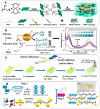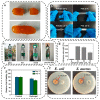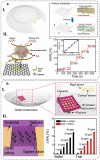Electrochemical Wearable Biosensors and Bioelectronic Devices Based on Hydrogels: Mechanical Properties and Electrochemical Behavior
- PMID: 37622909
- PMCID: PMC10452289
- DOI: 10.3390/bios13080823
Electrochemical Wearable Biosensors and Bioelectronic Devices Based on Hydrogels: Mechanical Properties and Electrochemical Behavior
Abstract
Hydrogel-based wearable electrochemical biosensors (HWEBs) are emerging biomedical devices that have recently received immense interest. The exceptional properties of HWEBs include excellent biocompatibility with hydrophilic nature, high porosity, tailorable permeability, the capability of reliable and accurate detection of disease biomarkers, suitable device-human interface, facile adjustability, and stimuli responsive to the nanofiller materials. Although the biomimetic three-dimensional hydrogels can immobilize bioreceptors, such as enzymes and aptamers, without any loss in their activities. However, most HWEBs suffer from low mechanical strength and electrical conductivity. Many studies have been performed on emerging electroactive nanofillers, including biomacromolecules, carbon-based materials, and inorganic and organic nanomaterials, to tackle these issues. Non-conductive hydrogels and even conductive hydrogels may be modified by nanofillers, as well as redox species. All these modifications have led to the design and development of efficient nanocomposites as electrochemical biosensors. In this review, both conductive-based and non-conductive-based hydrogels derived from natural and synthetic polymers are systematically reviewed. The main synthesis methods and characterization techniques are addressed. The mechanical properties and electrochemical behavior of HWEBs are discussed in detail. Finally, the prospects and potential applications of HWEBs in biosensing, healthcare monitoring, and clinical diagnostics are highlighted.
Keywords: biocompatible polymer; electroactive hydrogel; electrochemistry; flexible biosensors; mechanical behavior.
Conflict of interest statement
The authors declare no conflict of interest.
Figures












Similar articles
-
Stimuli-bioresponsive hydrogels as new generation materials for implantable, wearable, and disposable biosensors for medical diagnostics: Principles, opportunities, and challenges.Adv Colloid Interface Sci. 2023 Jul;317:102920. doi: 10.1016/j.cis.2023.102920. Epub 2023 May 13. Adv Colloid Interface Sci. 2023. PMID: 37207377 Review.
-
Recent advances in conductive polymer hydrogel composites and nanocomposites for flexible electrochemical supercapacitors.Chem Commun (Camb). 2021 Dec 23;58(2):185-207. doi: 10.1039/d1cc05526g. Chem Commun (Camb). 2021. PMID: 34881748 Review.
-
Advances in conducting nanocomposite hydrogels for wearable biomonitoring.Chem Soc Rev. 2025 Mar 3;54(5):2595-2652. doi: 10.1039/d4cs00220b. Chem Soc Rev. 2025. PMID: 39927792 Review.
-
Conductive Polymer-Based Hydrogels for Wearable Electrochemical Biosensors.Gels. 2024 Jul 12;10(7):459. doi: 10.3390/gels10070459. Gels. 2024. PMID: 39057482 Free PMC article. Review.
-
Flexible and wearable electrochemical biosensors based on two-dimensional materials: Recent developments.Anal Bioanal Chem. 2021 Jan;413(3):727-762. doi: 10.1007/s00216-020-03002-y. Epub 2020 Oct 23. Anal Bioanal Chem. 2021. PMID: 33094369 Free PMC article. Review.
Cited by
-
Advancements in Wearable and Implantable BioMEMS Devices: Transforming Healthcare Through Technology.Micromachines (Basel). 2025 Apr 28;16(5):522. doi: 10.3390/mi16050522. Micromachines (Basel). 2025. PMID: 40428648 Free PMC article. Review.
-
Continuous and Non-Invasive Lactate Monitoring Techniques in Critical Care Patients.Biosensors (Basel). 2024 Mar 18;14(3):148. doi: 10.3390/bios14030148. Biosensors (Basel). 2024. PMID: 38534255 Free PMC article. Review.
-
Microfluidic technologies for wearable and implantable biomedical devices.Lab Chip. 2025 Sep 9;25(18):4542-4576. doi: 10.1039/d5lc00499c. Lab Chip. 2025. PMID: 40836841 Free PMC article. Review.
-
Characterization of Schiff base self-healing hydrogels by dynamic speckle pattern analysis.Sci Rep. 2024 Nov 14;14(1):27950. doi: 10.1038/s41598-024-79499-5. Sci Rep. 2024. PMID: 39543160 Free PMC article.
-
Silicon-Based Biosensors: A Critical Review of Silicon's Role in Enhancing Biosensing Performance.Biosensors (Basel). 2025 Feb 18;15(2):119. doi: 10.3390/bios15020119. Biosensors (Basel). 2025. PMID: 39997021 Free PMC article. Review.
References
-
- Zhu P., Peng H., Rwei A.Y. Flexible, Wearable Biosensors for Digital Health. Med. Nov. Technol. Devices. 2022;14:100118. doi: 10.1016/j.medntd.2022.100118. - DOI
-
- Haleem A., Javaid M., Singh R.P., Suman R., Rab S. Biosensors Applications in Medical Field: A Brief Review. Sens. Int. 2021;2:100100. doi: 10.1016/j.sintl.2021.100100. - DOI
Publication types
MeSH terms
Substances
LinkOut - more resources
Full Text Sources

